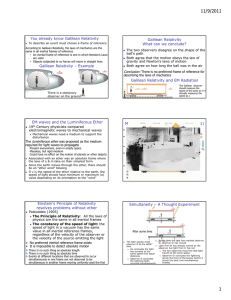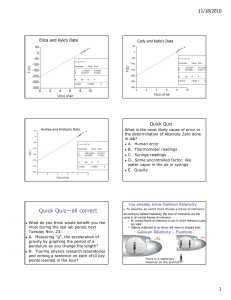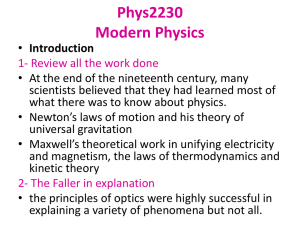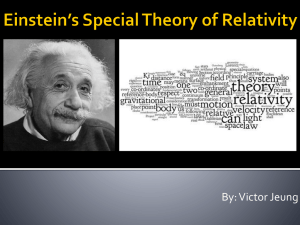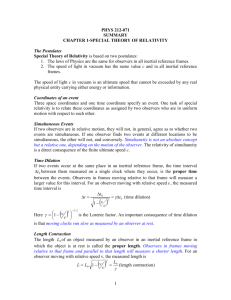Chapter 29 Physics of the Atom
advertisement
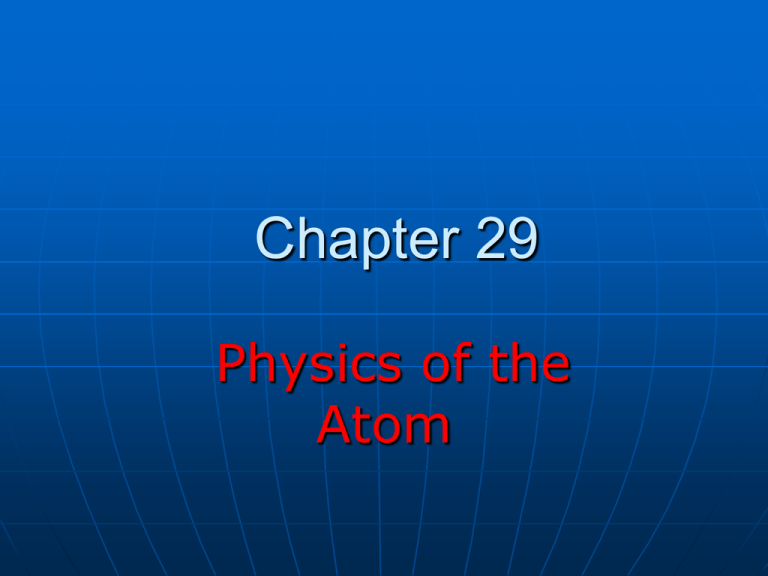
Chapter 29 Physics of the Atom A Brief Overview of Modern Physics 20th Century revolution • 1900 Max Planck Basic ideas leading to Quantum theory • 1905 Einstein Special Theory of Relativity 21st Century • Story is still incomplete Basic Problems The speed of every particle in the universe always remains less than the speed of light Newtonian Mechanics is a limited theory • It places no upper limit on speed • It is contrary to modern experimental results • Newtonian Mechanics becomes a specialized case of Einstein’s Theory of Special Relativity When speeds are much less than the speed of light Galilean Relativity Choose a frame of reference • Necessary to describe a physical event According to Galilean Relativity, the laws of mechanics are the same in all inertial frames of reference • An inertial frame of reference is one in which Newton’s Laws are valid • Objects subjected to no forces will move in straight lines Galilean Relativity – Example A passenger in an airplane throws a ball straight up • It appears to move in a vertical path • The law of gravity and equations of motion under uniform acceleration are obeyed Galilean Relativity – Example, cont There is a stationary observer on the ground • Views the path of the ball thrown to be a parabola • The ball has a velocity to the right equal to the velocity of the plane Galilean Relativity – Example, conclusion The two observers disagree on the shape of the ball’s path Both agree that the motion obeys the law of gravity and Newton’s laws of motion Both agree on how long the ball was in the air Conclusion: There is no preferred frame of reference for describing the laws of mechanics Galilean Relativity – Limitations Galilean Relativity does not apply to experiments in electricity, magnetism, optics, and other areas Results do not agree with experiments • The observer should measure the speed of the pulse as v+c • Actually measures the speed as c Newtonian Mechanics 1. In the absence of forces, a body moves with uniform speed in a straight line. 2. In the presence of force, the body changes its state of motion in such a way that (mv ) F t Ft p Based on the premise of Absolute Space and Absolute Time. Newton wrote “Absolute space in its own nature, without relation to any external, remains always similar and immovable.” “But because the parts of space cannot be seen, or distinguished from one another by our senses, therefore in their stead we use sensible measures of them. For from the positions and distances of things from any body considered as immovable, we define all places; and then with respect to such places, we estimate all motions, considering bodies are transferred from some of those places into others. And so, instead of absolute places and motions, we use relative ones; and without any inconvenience in common affairs. - Isaac Newton - However, Newton himself recognized that there is an ambiguity in his argument. Newton’s law of mechanics holds true in any inertial frames. platforms moving with a uniform speed Relative to a platform z z’ r = (x,y,z) x x’ vt y y’ r = (x’,y’,z’) x’ = x – vt y’ = y z’ = z vx’ = vx – v vy’ = vy vz’ = vz Luminiferous Ether 19th Century physicists compared electromagnetic waves to mechanical waves • Mechanical waves need a medium to support the disturbance The luminiferous ether was proposed as the medium required (and present) for light waves to propagate • Present everywhere, even in space • Massless, but rigid medium • Could have no effect on the motion of planets or other objects Verifying the Luminiferous Ether Associated with an ether was an absolute frame where the laws of e & m take on their simplest form Since the earth moves through the ether, there should be an “ether wind” blowing If v is the speed of the ether relative to the earth, the speed of light should have minimum or maximum values depending on its orientation to the “wind” Michelson-Morley Experiment First performed in 1881 by Michelson Repeated under various conditions by Michelson and Morley Designed to detect small changes in the speed of light • By determining the velocity of the earth relative to the ether Michelson-Morley Equipment Used the Michelson Interferometer Arm 2 is aligned along the direction of the earth’s motion through space The interference pattern was observed while the interferometer was rotated through 90° The effect should have been to show small, but measurable, shifts in the fringe pattern Michelson-Morley Results Measurements failed to show any change in the fringe pattern • No fringe shift of the magnitude required was ever observed Light is now understood to be an electromagnetic wave, which requires no medium for its propagation • The idea of an ether was discarded The laws of electricity and magnetism are the same in all inertial frames Einstein’s Principle of Relativity Resolves the contradiction between Galilean relativity and the fact that the speed of light is the same for all observers Postulates • The Principle of Relativity: All the laws of physics are the same in all inertial frames • The constancy of the speed of light: the speed of light in a vacuum has the same value in all inertial reference frames, regardless of the velocity of the observer or the velocity of the source emitting the light The Principle of Relativity This is a sweeping generalization of the principle of Galilean relativity, which refers only to the laws of mechanics The results of any kind of experiment performed in a laboratory at rest must be the same as when performed in a laboratory moving at a constant speed past the first one. No preferred inertial reference frame exists It is impossible to detect absolute motion The Constancy of the Speed of Light Been confirmed experimentally in many ways • A direct demonstration involves measuring the speed of photons emitted by particles traveling near the speed of light • Confirms the speed of light to five significant figures Explains the null result of the MichelsonMorley experiment Relative motion is unimportant when measuring the speed of light • We must alter our common-sense notions of space and time Consequences of Special Relativity Restricting the discussion to concepts of length, time, and simultaneity In relativistic mechanics • There is no such thing as absolute length • There is no such thing as absolute time • Events at different locations that are observed to occur simultaneously in one frame are not observed to be simultaneous in another frame moving uniformly past the first L tout tin L / c ttotal 2 L / c In 19th century, physicists believed in luminiferous ether and that Light travels with the speed of light,c relative to this light medium. Now, let’s consider the effect that we are making this measurement on the surface of earth which is moving through the ether with a speed v, close to 18 miles/s Moving with v L L ctout L vtout ctin L vtin tout L /( c v) tin L /( c v) L L 2L 1 ttotal tout tin 2 2 cv cv c (1 v / c ) However, Michelson-Morley’s experiment showed with a high precision ttotal = 2L/c Accurate measurements of speed of light give the value c = 2.998 x 108 m/s no matter how the light source or/and the measurer are moving!! Serious conflict with then current understanding based on Newtonian world. Albert Einstein (1879 – 1955) In 1905, He provided a new view on space-time,and proposed a new theory of mechanics which is consistent with Newtonian mechanics in the limit of low speed. 1921 Nobel Prize in Physics “for his services to Theoretical Physics, and especially for his discovery of the law of the photoelectric effect" In his 1905 paper, Einstein proposes: … the same law of electrodynamics and optics will be valid for all frames of reference for which the equation of mechanics hold good. We will raise this conjecture (the purport of which will hereafter be called the “Principle of Relativity”) to the status of a postulate…. a fundamental physical constant + the experimental observation that the speed of light is c regardless Of the reference frame where the light source or the observer resides. 1. Neither an object nor any form of energy can be accelerated to a speed as fast as or faster than c. 2. The mass of an object increases when its speed increases. 3. Mass is a form of energy in the sense that mass and energy can be interchanged. 4. An observer observes that the clock moving with a speed relative to the observer is clicking slower than his. 5. When a long object is moving fast in its length direction passing by an observer, the observer will measure the length of the object is shorter than that at rest relative to the observer. Time Dilation Einstein Clock L 1 round trip time = 2L/c is longer than Time interval from the point of view of the stationary observer = Time interval from the point of view of the observer moving with The clock 1 1 v2 / c2 Time Dilation, Summary The time interval Δt between two events measured by an observer moving with respect to a clock is longer than the time interval Δtp between the same two events measured by an observer at rest with respect to the clock A clock moving past an observer at speed v runs more slowly than an identical clock at rest with respect to the observer by a factor of 1 v 2 / c 2
